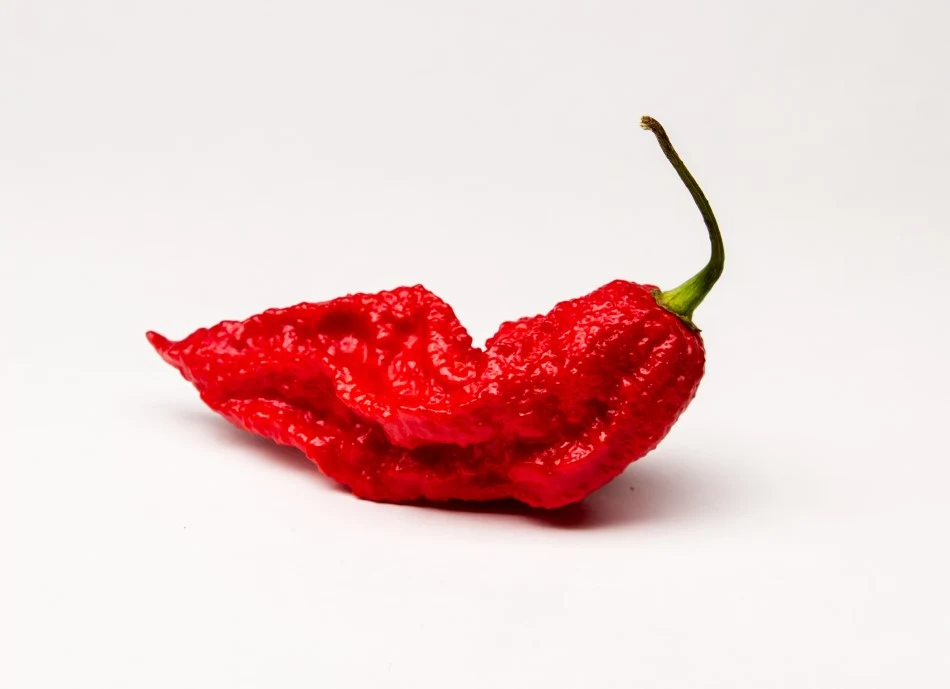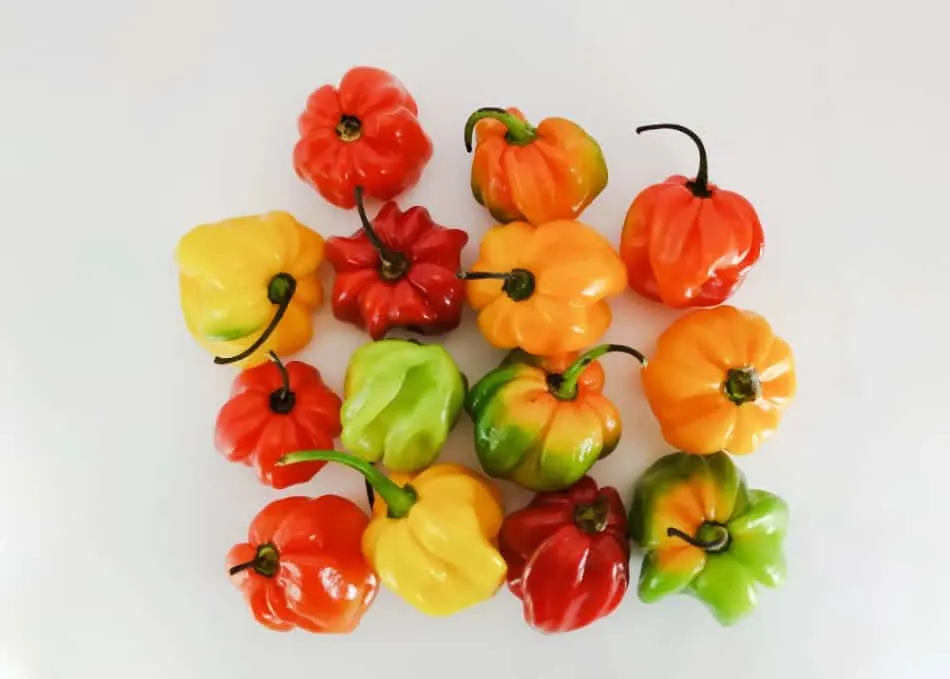Who doesn’t like a bit of spice in their life? However, with so many chili and pepper variations in the market, you might be wondering which ones are worth including in your shopping list. To many spicy food connoisseurs, Scotch Bonnet and Ghost Peppers take the cake, but which is the best in terms of taste, size, smell, and versatility?
Ghost peppers are extremely spicy and can turn any mild dish into a mouth-burning meal. The Scotch Bonnet pepper has a sweeter tone and less heat. Both pepper varieties are flavorful and create unique taste combinations.
So which chili is the best in terms of flavor profile, color, and versatility? We’ll delve further into what these peppers are and the qualities they boast to determine a rightful winner in the Scotch Bonnet vs. Ghost Pepper debate. Let’s begin!

What is a Scotch Bonnet Pepper?
A Scotch Bonnet, or the Caribbean red pepper, is a small, hot pepper variety that packs intense heat. Scotch Bonnet is part of the Habanero pepper family and is common in West African and Caribbean cooking.
These spicy peppers measure from 100,000 and 350,000 SHU (Scoville Heat Units), making them a blazing pepper among spice lovers. Their heat levels make them 40 times hotter than your average Jalapeño pepper.
These fiery peppers come in vibrant shades of green, red, yellow, and orange, making them a colorful addition to any of your dishes. They are hot like Habaneros, making them a fearsome contender against chilis like the Red Savina Habanero (500,000 SHU) and Habanero Pepper (350,000 SHU.)
Experts warn us to always cook the Scotch Bonnet in a well-ventilated room to avoid the fumes burning into our noses and eyes. They should not touch your skin so make sure to wear protective gloves. Once the seeds are removed, the Scotch Bonnet becomes a flavor powerhouse among other ingredients!
What are Ghost Peppers?
Bhut Jolokia, or Ghost Peppers/Bhutanese chili, come from India and Bangladesh and hold the mantle as one of the spiciest peppers in the world. A Ghost Pepper is a hybrid pepper variety that combines the Capsicum chinense and Capsicum frutescens, making it a challenge among spice lovers.
It is exceptionally spicy and has been part of many authentic, classy, and traditional Indian and Bangladeshi dishes. In terms of Scoville rating, the Ghost Pepper stands tall at 1,041,427 SHU, which means that it is over 200 times hotter than a regular Jalapeño pepper!
Of course, it holds this near formidable position with other chilis like the Carolina Reaper (1,569,300 SHU on average) and the Trinidad Scorpion Butch T pepper (1,300,700 SHU). Ghost Peppers come in a variety of bright colors like:
- Yellow
- Red
- Chocolate
- Purple
- Peach
You will find Ghost Peppers in various sauces, spicy curries, and the limelight of many food challenges!

Scotch Bonnet vs. Ghost Pepper: Which One is Best?
The Scotch Bonnet and Ghost Pepper fare amazingly among many other extremely spicy peppers in the market. Their heat, smell, and overall features make them a favorite among spice lovers. But which one is better and more popular among home cooks, food bloggers, and general food connoisseurs? Let us find out:
Heat Levels
In terms of hotness, Ghost Peppers hover around 1,041,427 SHU, compared to the 350,000 SHU that the Scotch Bonnet carries.
The Ghost Pepper is excruciatingly hot and can make you feel dizzy, with ringing ears. The Guinness World Record in 2007 concluded that the Ghost Pepper is the hottest chili pepper in the world.
The Carolina Reaper eventually dethroned the Ghost Pepper on August 11, 2017. Check out our comprehensive list of the hottest peppers to learn more!
The Ghost Pepper is almost four times hotter than the Scotch Bonnet and does not have the relatively mild sweetness that the latter holds. The Scotch Bonnet is a Capsicum chinense variety, while the Ghost Pepper is a hybrid of both the Chinense and Frutescens variants.
Ghost peppers are pure heat, while the Scotch Bonnet is more flavorful.
Flavor Profile
When it comes to flavor, the Scotch Bonnet takes the lead.
Its mildly fruity, sweet, and tangy flavor is a nice addition to its spicy flavor. On the other hand, Ghost Pepper’s flavor is often lost when you cook with it.
The Ghost pepper also holds a beautiful hint of smokiness, making it a fan favorite dipping sauce at barbecues.
When you eat a Scotch Bonnet pepper, you will taste a sort of apple and cherry-like sweetness hitting your mouth. After this hint of sweetness, you will feel the extreme heat rushing in, blending with the sweetness. Of course, this experience might vary depending on where the pepper was grown.
In the case of a Ghost Pepper, its sweet and spicy flavor hits best when you eat it raw. During the first 30 seconds, you might not feel anything other than these mild and flavorful hits. Right after the 40-second mark, you might find yourself sweating, tearing up, breathing heavily (with trouble), and hiccupping. It takes about 40 minutes for this effect to subside.
Size of Pepper
The Scotch Bonnet measures between 1.5 to 2 inches (3.8 to 5 cms) long.
They are little round or bulbous peppers and can be a bit shiny. As their name suggests, they look like tiny Scotsman bonnets and also have nicknames like:
- The Jamaican Hot
- Martinique pepper
- Bahama Mama
- The Bahamian
Ghost peppers, on the other hand, usually range from 2.4 to 3.3 inches (6.1- 8.4 cms) when mature.
Unlike Scotch Bonnets that have a squashed appearance, Ghost peppers are more expansive and look like pendants. They have a pointy structure and an uneven, bumpy texture. These peppers have distinctive looks.
Color of Peppers
Both of these varieties are beautifully dynamic in color. The Scotch Bonnet comes in some vibrant colors like:
- Green (when unripe)
- Red
- Peach
- Orange
- Yellow
- Chocolate Brown
Ghost peppers also come in pretty different colors. Some of them include:
- Yellow
- Red
- Orange
- Chocolate
- Purple
As a Ghost Pepper ripens, it becomes a beautiful shade of bright yellow. Sometimes these pepper can also be found in peach and purple hues. They have fragile skins, which make them look plump and delectable. These peppers, when unripe, have a lighter shade and become darker as they mature.
Both Scotch Bonnets and Ghost Peppers eventually turn a bright shade of red and are ready to add some spicy flavors to your dishes.
Foods That Each Pepper Pairs Well With
One of the classic recipes to try out with the Scotch Bonnet pepper is Caribbean Jerk Chicken. This tasty chicken dish, loaded with juicy and tender pieces, benefits from the tangy, sweet, and spicy heat of the pepper. You can also go for:
- Jamaican Beef Patties
- Slow-Cooked BBQ Lamb Ribs
- Jollof Rice
- Vegan Stew Peas
- Crispy Pig Ears
- Jamaican Saltfish
These dishes are packed to the tee with the best blends of flavors, with juicy, succulent, fall-off-the-bone meat and the most fragrant rice and stews. The Scotch Bonnet pepper boosts flavor, making it a crowd favorite for those that enjoy spice.
While you can always go the traditional way with Ghost peppers by using them in chicken wing sauce, pasta, and pizzas, you may want to consider some more exotic recipes will make your mouth water. Such recipes include:
- Ghost pepper jelly
- Spicy Ghost-Peppered Candied Bacon
- Ghost Pepper Pineapple Pear Hot Sauce
- Ghost Pepper Salted Scallops
- Chili Oil (You can add it to anything!)
- Ghost Pepper Honey Dips
Thanks to its smoky and diverse flavor, the Ghost Pepper reigns supreme in experimenting with some great dishes and ingredients for your meals.
How Long Each Pepper Takes To Grow, Fruit, and Ripen
Scotch Bonnet peppers can take 120 days to grow. They need fertilizer from a very young age. At two to three weeks after they sprout, transplant them for better growth. It takes around 120-days to go from seedling to the fruiting and harvesting stage.
All in all, it takes four to five months, or around 150 days, for Ghost Peppers to grow and harvest. Ghost Peppers have four growth stages:
- Seedling stage (35 days)
- Vegetative stage (six to eight weeks)
- Flowering and fruiting (one to two weeks)
- Ripening stage (four to six weeks)
Closing Thoughts
Overall, if you are a spice lover, it may be hard to decide which of these great peppers wins the battle. In our opinion, the Scotch Bonnet takes the cake, for its versatility and it’s more manageable heat levels.
But, if you can handle the heat, Ghost peppers are the way to go for that smoky, blazing flavor.
